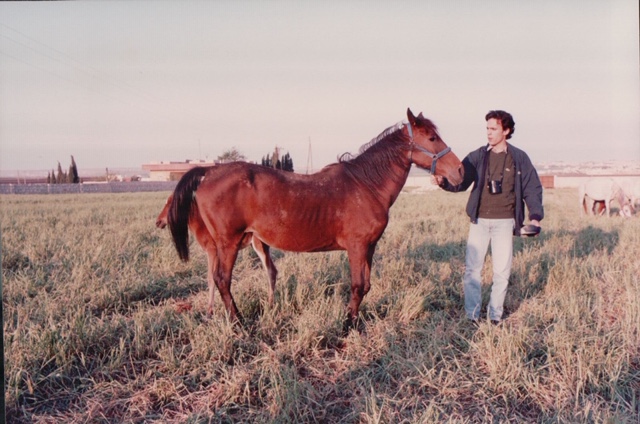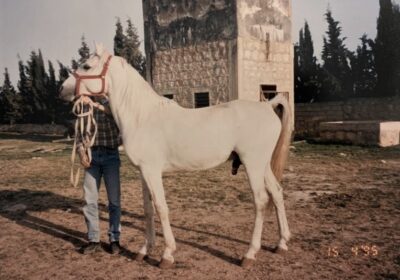Down memory lane: Dahess 1987 Ubayyan Suhayli from Syria
This evening I had a bout of nostalgia for my old horses, so I went looking for pictures of Dahess, the desert-bred stallion my father and I bought from a racing stable in Beirut in 1993. I was 15.
One afternoon, as I was just coming back from school, my father told me that he had been contacted by the secretariat of the organization managing the Beirut racetrack about two Arabian stallions that had recently been imported from Qatar, one of them a Syrian horse of desert lines. They were being housed at one of the racing stables on the road to the airport. Both were for sale. I pressed to drive down to the racetrack to see them at once.
Half an hour later, we were standing in front of two stallions, an exquisitely balanced grey with a milky white coat, 14.3 hands, and a much taller, loosely built cherry bay. The grey we were told was “Syrian” and the bay “Russian”. Both were a bit thin. My father nudged me from his elbow, and started praising the bay horse, while deliberately turning his back to the grey one. The groom fell for the trick and hinted that the bay may not be for sale after all, or only for a high price, that he needed to consult with the owner, etc., etc. The grey could be had immediately, however. My father made an offer for 1,000 USD which was accepted, and the horse was ours. The groom offered to geld him, and was surprised at our answer. As we left, he said with a wink: “you got the better one of the two”.
We transferred Dahess to the stables of Nabil De Freije, which were located within the walls of the racetrack compound. Dahess began training and scored excellent trial times. “Minus 14”, I often heard the trainer say with satisfaction. That meant he was running a mile in two minutes minus fourteen seconds. Dahess remained in training for several months.
One evening during our yearly summer visit to Aleppo, my father made it a point to tell his friend Radwan Shabareq that he now had a better stallion than Radwan’s senior stallion al-Aawar. This was a bold statement, given the consensus among veteran Alepine breeders about al-Aawar’s status as the best stallion around. My father was pressed to back up his claim with an extensive comparison of both horses’ merits that went well on into the night in Mustafa al-Jabri’s office. The result of the exercise was a virtual tie, but my father persisted in his claim nonetheless.
The next day, during a visit at his farm, Radwan announced to my father that he would be sending his mentor and trusted agent Abd al-Qadir Hammami (“a man of horses”) to Beirut to check out Dahess and report back to him. Radwan even offered my father a filly of his choice from this year’s crop of foals in exchange for Dahess, but only if Hammami declared that Dahess was superior to al-Aawar overall. He seemed fairly sure this would not be the case.
The week after our return, Hammami, then in his late eighties, arrived in Beirut after a five-hour trip by bus from Aleppo. He made his way directly to the stables to see Dahess and phoned our house from the racetrack office so we could pick him up. He had a small problem: he had indeed found Dahess to be the better horse overall, and was worried about announcing his finding to Radwan. After all, he was the one who had selected al-Aawar for Radwan. Hammami stayed for lunch and we had a three hours discussion about racehorses of the past after my return from school. We then called Radwan, who had old Hammami repeat the outcome of his assessment three times before he believed him!
Radwan promptly sent a truck to ship Dahess to Aleppo, and my father chose a young bay Krush filly in exchange for the stallion. Ironically, the filly was a daughter of al-Aawar and of the old, lame Krush of Nuri al-Jarba (below, with the chosen filly behind the mare, and a young me holding the mare).

Dahess stood at stud for three seasons (1994, 1995, 1996), including the middle 1995 season at Mustafa al-Jabri’s farm — before dying of a heart attack in 1996 after he got loose and began chasing mares.
I found these two pictures of him taken at the Jabri farm in April 1995. It must have been during Easter break. I am holding him in the first one, while Razzaq, Mustafa’s head groom is in the second photo, which I took. I still remember how Dahess lifted his leg and ruined the last photo of my last 36-photo film. It would have otherwise been a perfect shot.


Thank you for sharing Dahess’s story. He was a very good-looking horse! Am giggling at that last photo with the lifted leg; guess he’d pass a hock flexion test, no problem.
Very oriental photos of Dahess. We know the race results of Dahess in Qatar; I guess he would run with Anglos! Concerning the Amsha krush she has a good sport type better than her own brother Ammoori.
The photos are iPhone snapshots of the actual photos. I had a bout of the lazies on top of my nostalgitis, so I did not use the scanner. I will try to get better resolution photos later.
And now, Dahess Hassaka is the offspring of both, Dahess and Al Aawar
Yes!!! and of Marzouq too. This was the magical trio. I found really nice pictures of Marzouq yesterday
Precious memories. Thank you for sharing!
مشكور استاذ ادوارد على هذه المعلومات القيمة . هل المهرة الكروش كان اسمها عمشة شمر بنت غلاية والاعور.
Amshet Shammar ( Al aawar * GHALLAIEH )
Khalid, nice to hear from you. You are right, this was Amshet Shammar, I gave her this name. I wonder what happened to her, after she was sold.
afterword she went to Mr. Nizar Al Asaad stables in Damascus, i didn’t find any more details about it, unfortunately.
this is another picture of Dahees
http://daughterofthewind.org/wp-content/uploads/2010/11/Dahess1-400×260.jpg
Yes, this one was in 1996, shortly before his death. I took this one too, it’s one of several in a series.
i will forward to you a nice picture for Dahees from your own series. check you messenger.
yes, it was taken moments before the other one..
That gray is my type of horse. He is perfect in every way.